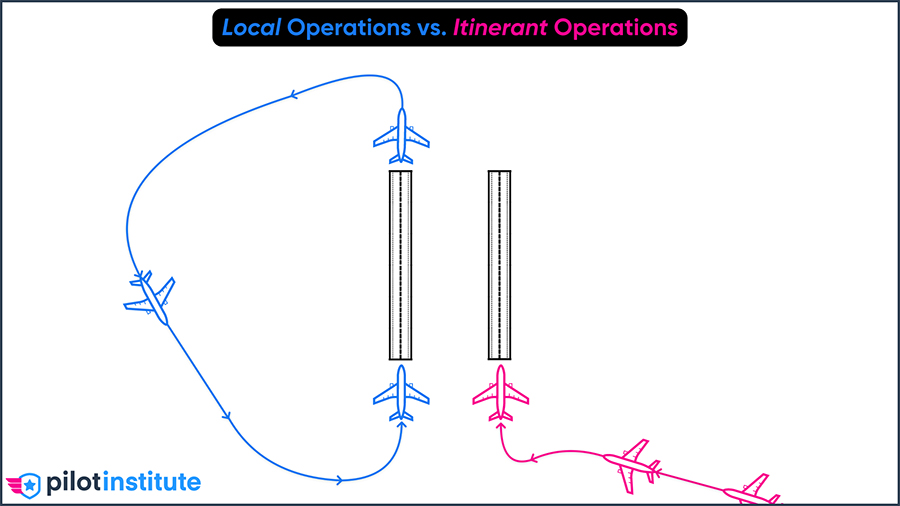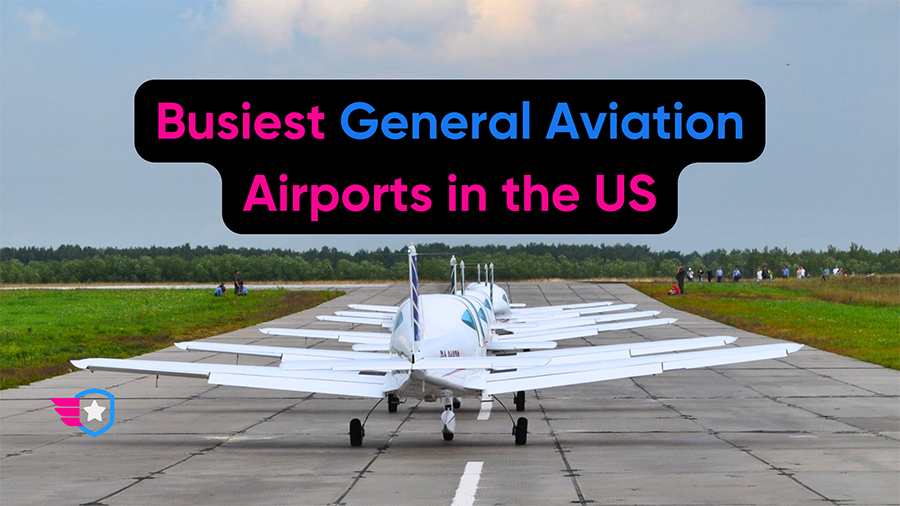-
What is an Operation?
-
1. Phoenix Deer Valley Airport (KDVT)
- Phoenix, Arizona
-
2. Centennial Airport (KAPA)
- Denver, Colorado
-
3. Montgomery-Gibbs Executive Airport (KMYF)
- San Diego, California
-
4. Prescott Regional Airport - Ernest A Love Field (KPRC)
- Prescott, Arizona
-
5. Rocky Mountain Metropolitan Airport (KBJC)
- Denver, Colorado
-
6. Long Beach Airport (Daugherty Field) (KLGB)
- Los Angeles, California
-
7. Portland–Hillsboro Airport (KHIO)
- Portland, Oregon
-
8. Falcon Field (KFFZ)
- Mesa, Arizona
-
9. Chandler Municipal Airport (KCHD)
- Chandler, Arizona
-
10. Grand Forks International Airport (KGFK)
- Grand Forks, North Dakota
-
What is “General Aviation?”
-
Local Operations vs. Itinerant Operations
Ever wondered which general aviation airports in the U.S. handle the most takeoffs and landings?
Today, we’ll explore the busiest general aviation airports in the US based on General Aviation (GA) operations per year.
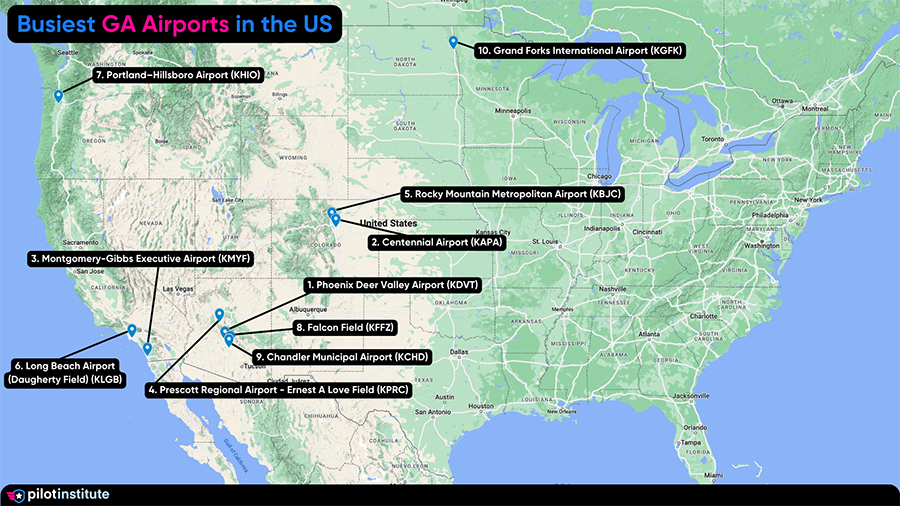
Here’s the list:
- Phoenix Deer Valley Airport (KDVT) – Phoenix, Arizona
- Centennial Airport (KAPA) – Denver, Colorado
- Montgomery-Gibbs Executive Airport (KMYF) – San Diego, California
- Prescott Regional Airport – Ernest A Love Field (KPRC) – Prescott, Arizona
- Rocky Mountain Metropolitan Airport (KBJC) – Denver, Colorado
- Long Beach Airport (Daugherty Field) (KLGB) – Los Angeles, California
- Portland–Hillsboro Airport (KHIO) – Portland, Oregon
- Falcon Field (KFFZ) – Mesa, Arizona
- Chandler Municipal Airport (KCHD) – Chandler, Arizona
- Grand Forks International Airport (KGFK) – Grand Forks, North Dakota
What is an Operation?
In short, an operation is any takeoff or landing.
Let’s say you’re flying in a traffic pattern. An entire traffic pattern would count as two operations (one takeoff and one landing).
Now get ready for some mind-blowing numbers.
1. Phoenix Deer Valley Airport (KDVT)
Phoenix, Arizona
397,329 Operations
The busiest General Aviation airport in the US is Phoenix Deer Valley Airport in Phoenix, Arizona.
This airport is a hive of activity and serves as a major hub for flight training. It’s the base for two of the largest flight schools in the country (AeroGuard and Westwind School of Aeronautics), and several large Fixed Base Operators (FBOs).
The result? A constant symphony of departures, arrivals, and training maneuvers in the skies over Phoenix.
With the combination of its location, services, suitable weather conditions, and training operations, Phoenix Deer Valley Airport takes the number one spot on our list.
2. Centennial Airport (KAPA)
Denver, Colorado
312,153 Operations
Up next, we’re making our way to the Mile-High City, home to the Centennial Airport. Located in Denver, Colorado, this airport is no stranger to activity.
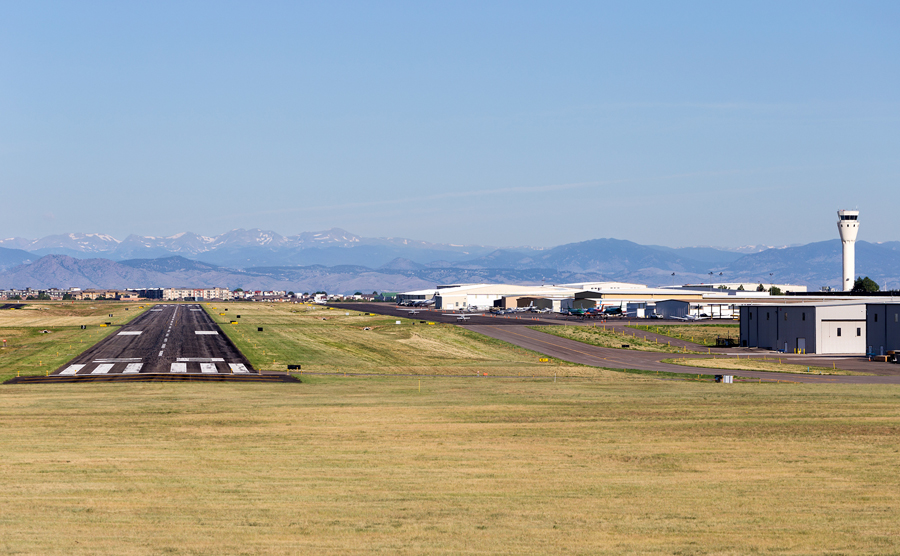
Why is KAPA in the second spot? Well, Centennial isn’t just about flight training, though it hosts several flight schools. It’s a preferred destination for business aviation and private jet traffic, largely due to its proximity to downtown Denver and the south Denver metro area.
The airport’s strategic location, coupled with an influx of general aviation traffic, business flights, and flight training, all contribute to Centennial’s bustling runways.
3. Montgomery-Gibbs Executive Airport (KMYF)
San Diego, California
272,813 Operations
Now we’re off to the sunny shores of California. Nestled in San Diego, the Montgomery-Gibbs Executive Airport presents a hive of aviation activity. With a staggering 272,813 operations, this airport firmly holds the third spot on our list.
But what makes Montgomery Gibbs so busy? Well, the answer lies in its multifaceted operations.
Serving as an essential general aviation gateway to the city, the airport is used for flight training, corporate aviation, military, and law enforcement activities.
Its location, coupled with the diversity of its operations, makes this airport a hot spot for general aviation traffic.
4. Prescott Regional Airport – Ernest A Love Field (KPRC)
Prescott, Arizona
256,931 Operations
We’re back in Arizona, this time in the desert city of Prescott, home to Prescott Regional Airport (and our headquarters!). Here, the sky’s always buzzing with activity, demonstrated by a hefty 256,931 operations.
What’s behind KPRC’s heavy traffic? A considerable portion of it comes from Embry-Riddle Aeronautical University, renowned for its premier flight training program. The airport also serves corporate and military activities.
Its desert location offers more than 300 days of perfect flying conditions annually, making it ideal for flight training.
Between the university’s bustling flight training schedule, general aviation flights, and the unbeatable weather, KPRC is a significant contributor to the US general aviation landscape.
5. Rocky Mountain Metropolitan Airport (KBJC)
Denver, Colorado
249,063 Operations
Now, let’s head back to the Rocky Mountain state, home to the Rocky Mountain Metropolitan Airport.
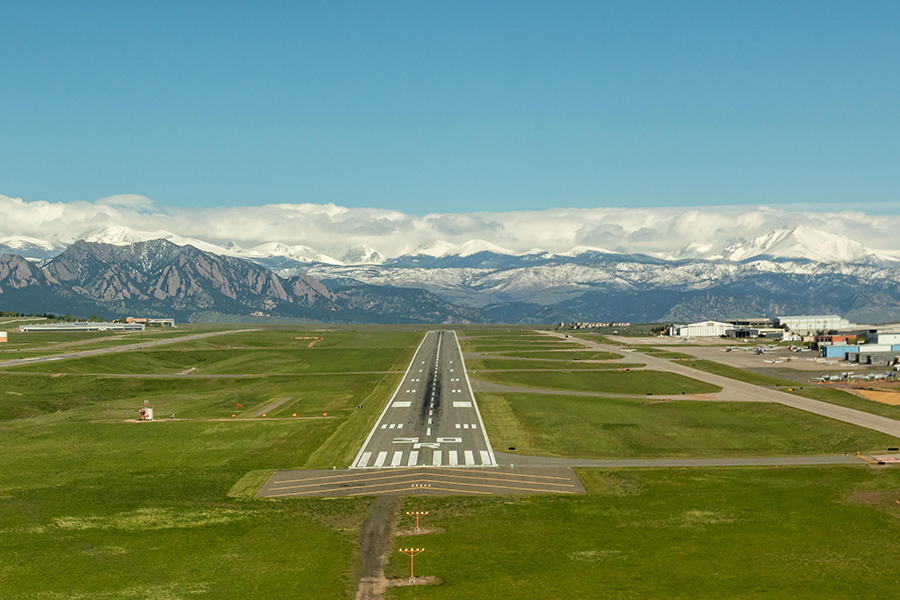
So why does KBJC see lots of traffic? The answer lies in its diverse range of operations. The airport hosts several flight schools, contributing a significant number of training flights. It’s also a popular choice for business aviation, given its strategic location between Denver and Boulder.
Its unique blend of training flights, business traffic, and general aviation, backed by Colorado’s favorable flying weather, keeps the runways at KBJC buzzing throughout the year.
6. Long Beach Airport (Daugherty Field) (KLGB)
Los Angeles, California
247,689 Operations
Let’s jet over to the sunny state of California, to Los Angeles’s Long Beach Airport, also known as Daugherty Field. With a lively 247,689 operations, it takes the sixth spot on our list.
Long Beach is more than just an airport; it’s a buzzing hive of aeronautical activity. It’s a vital player in the industry, hosting several flight schools, making it a significant hub for flight training.
Plus, it’s a preferred spot for private and business aviation, thanks to its location in the heart of Southern California.
Combine the flight training activity with the business and private aviation traffic, and you’ve got one busy airport.
7. Portland–Hillsboro Airport (KHIO)
Portland, Oregon
243,642 Operations
Our next stop takes us north to the beautiful Pacific Northwest, specifically to Portland, Oregon, home to the Portland–Hillsboro Airport.
What keeps the Portland-Hillsboro runways so busy? Besides general aviation traffic, the airport is a hub for flight training. With several flight schools operating out of KHIO, there’s a steady stream of training flights making their rounds each day.
Moreover, its strategic location in the tech-heavy Silicon Forest makes it a preferred airport for corporate aviation.
8. Falcon Field (KFFZ)
Mesa, Arizona
238,766 Operations
Next, we journey back to Arizona to visit the city of Mesa, home to Falcon Field. Holding its own with an impressive 238,766 operations, this airport lands the eighth spot on our list.
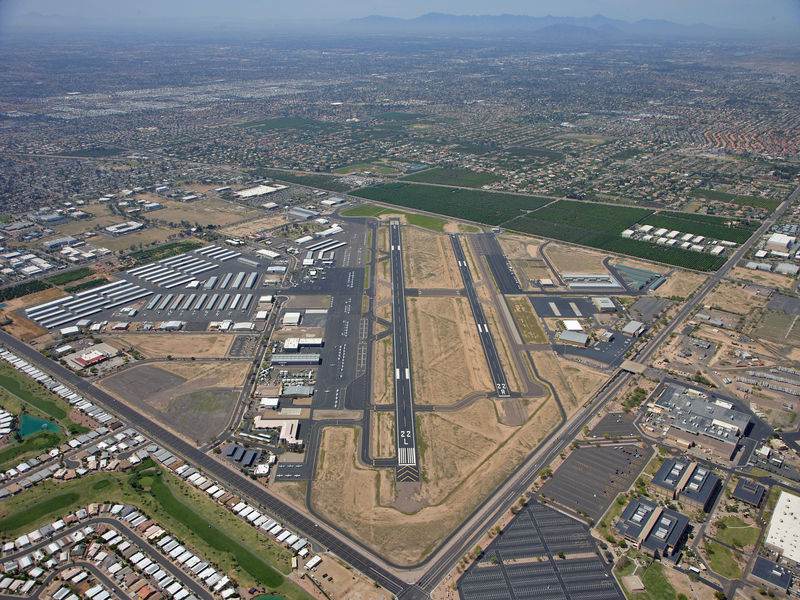
But what keeps Falcon Field’s traffic humming? A significant part of it is due to flight training. The airport serves as the base for several flight schools, which results in a constant influx of student pilots honing their skills.
Falcon Field also serves a broad spectrum of aviation activity, including corporate flights, military and law enforcement operations, and emergency medical services. This blend of diverse activities, coupled with Arizona’s year-round flying weather, makes Falcon Field a vibrant hub.
9. Chandler Municipal Airport (KCHD)
Chandler, Arizona
234,620 Operations
We’re staying in Arizona for our next spot, Chandler Municipal Airport. This bustling hub has a proud tally of 234,620 operations, earning it the ninth spot on our list.
Now, what’s behind Chandler’s busy air traffic? Once again, a lot of it can be attributed to flight training. Chandler Municipal Airport hosts a number of flight schools, which translates to a high frequency of training flights.
But that’s not all. Chandler Municipal also caters to general aviation, business flights, and air taxi services.
Its location, ideal weather, and mix of operations all contribute to its status as one of the busiest general aviation airports in the U.S.
10. Grand Forks International Airport (KGFK)
Grand Forks, North Dakota
229,610 Operations
Last on our radar is Grand Forks International Airport in North Dakota.
Interestingly, the key to Grand Forks International’s bustling activity lies solely in the world of flight training.
Grand Forks is home to the John D. Odegard School of Aerospace Sciences at the University of North Dakota, recognized as one of the top aviation schools in the country.
With legions of student pilots taking off, landing, and performing maneuvers throughout the day, the operation count quickly surges.
This constant buzz of training flights makes up the majority of the airport’s traffic, placing KGFK firmly on our list.
What is “General Aviation?”
What exactly does “general aviation” mean?
In a nutshell, general aviation encompasses all civil aviation activities that are not commercial (airline) or military flights.
This broad category includes activities like flight training, business flights, air taxi and charter services, emergency medical services, agricultural aviation, and personal flying for leisure or travel.
General aviation is an essential part of the aviation industry, making up a significant portion of the air traffic in the US.
Local Operations vs. Itinerant Operations
Today’s list is based on local and itinerant operations, but what’s the difference?
Local operations refer to flights that depart and stay within sight of the airport, while itinerant operations involve flights that arrive from other airports.
Some airports (like those used for flight training), have a significant number of local operations compared to itinerant operations.
Other airports (like those used for corporate flights) have a large number of itinerant operations.
